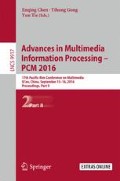Abstract
Traditional Chinese Medicine diagnoses a wide range of health conditions by examining morphology features of the tongue, such as fat, thin and normal. This paper presents an approach of classification for recognizing and analyzing tongue morphology based on geometric features and tongue-mouth relation feature. The geometric features are defined using various measurements of width and length of the tongue body, and ratio between them. In addition, an innovative and important feature is proposed based on the relationship between the width of the tongue body and the width of the oral cavity, named as tongue-mouth relation feature. All these features are used to train a SVM classifier. Experimental results show that the tongue-mouth relation feature is helpful to improve the recognition accuracy for tongue morphology, and the proposed method, tested on a total of 200 tongue samples, achieved an accuracy of more than 92%.
Access this chapter
Tax calculation will be finalised at checkout
Purchases are for personal use only
References
Kirschbaum, B.: Atlas of Chinese Tongue Diagnosis. Eastland Press, Seattle (2000)
Yiu, H., Shuai, X.Z.: Fundamental of Traditional Chinese Medicine. Foreign Languages Press, Beijing (1992)
Li, N., Zhang, D., Wang, K.: Tongue Diagnostics. Shed-Yuan Publishing, Beijing (2006)
Chiu, C.C., Lin, H.S., Lin, S.L.: A structural texture recognition approach for medical diagnosis through tongue. Biomed. Eng. Appl. Basis Commun. 7(2), 143–148 (1995)
Chiu, C.C.: A novel approach based on computerized image analysis for traditional Chinese medical diagnosis of the tongue. Comput. Methods Programs Biomed. 61(2), 77–89 (2000)
Pang, B., Zhang, D., Li, N., et al.: Computerized tongue diagnosis based on Bayesian networks. IEEE Trans. Biomed. Eng. 51(10), 1803–1810 (2004)
Pang, B., Zhang, D., Wang, K.: The bi-elliptical deformable contour and its application to automated tongue segmentation in Chinese medicine. IEEE Trans. Med. Imaging 24(8), 946–956 (2005)
Ning, J., Zhang, D., Wu, C., et al.: Automatic tongue image segmentation based on gradient vector flow and region merging. Neural Comput. Appl. 21(8), 1819–1826 (2012)
Li, X., Li, J., Wang, D.: Automatic tongue image segmentation based on histogram projection and matting. In: 2014 IEEE International Conference on Bioinformatics and Biomedicine (BIBM), pp. 76–81. IEEE (2014)
Liu, L.L., Zhang, D.: Extracting tongue cracks using the wide line detector. In: Zhang, D. (ed.) ICMB 2008. LNCS, vol. 4901, pp. 49–56. Springer, Heidelberg (2007). doi:10.1007/978-3-540-77413-6_7
Li, X., Shao, Q., Yao, Q.: Cracked tongue recognition using statistic feature. In: 2014 IEEE International Conference on Bioinformatics and Biomedicine (BIBM), pp. 72–73. IEEE (2014)
Shao, Q., Li, X., Fu, Z.: Recognition of teeth-marked tongue based on gradient of concave region. In: 2014 International Conference on Audio, Language and Image Processing (ICALIP), pp. 968–972. IEEE (2014)
Zhong, S., Wei, Y., Xie, G.: Research on a tooth-marked rapid locating method based on convex hulls. Microcomput. Inf. 25(3), 312–314 (2009)
Zhang, Y.T.: Research on analysis method of tongue and teeth-marked tongue. Doctor dissertation, Beijing University of Chinese Medicine (2005)
Wang, X., Zhang, B., Yang, Z., et al.: Statistical analysis of tongue images for feature extraction and diagnostics. IEEE Trans. Image Process. 22(12), 5336–5347 (2013)
Zhang, B., Kumar, B.V.K., Zhang, D.: Detecting diabetes mellitus and nonproliferative diabetic retinopathy using tongue color, texture, and geometry features. IEEE Trans. Biomed. Eng. 61(2), 491–501 (2014)
Wei, B., Shen, L.: Automatic analysis for plumpness and slenderness of tongue. Comput. Eng. 11 (2004)
Xu, J., Tu, L., Ren, H., et al.: A diagnostic method based on tongue imaging morphology. In: The 2nd International Conference on Bioinformatics and Biomedical Engineering, ICBBE 2008, pp. 2613–2616. IEEE (2008)
Huang, B., Wu, J., Zhang, D., et al.: Tongue shape classification by geometric features. Inf. Sci. 180(2), 312–324 (2010)
Joachims T. Introduction to support vector machines (2002)
Author information
Authors and Affiliations
Corresponding author
Editor information
Editors and Affiliations
Rights and permissions
Copyright information
© 2016 Springer International Publishing AG
About this paper
Cite this paper
Cui, Q., Li, X., Li, J., Zhang, Y. (2016). Geometric and Tongue-Mouth Relation Features for Morphology Analysis of Tongue Body. In: Chen, E., Gong, Y., Tie, Y. (eds) Advances in Multimedia Information Processing - PCM 2016. PCM 2016. Lecture Notes in Computer Science(), vol 9917. Springer, Cham. https://doi.org/10.1007/978-3-319-48896-7_48
Download citation
DOI: https://doi.org/10.1007/978-3-319-48896-7_48
Published:
Publisher Name: Springer, Cham
Print ISBN: 978-3-319-48895-0
Online ISBN: 978-3-319-48896-7
eBook Packages: Computer ScienceComputer Science (R0)

